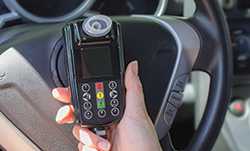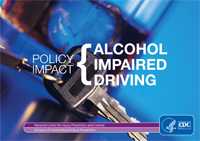Publications
 Lessons Learned from Implementing Alcohol Ignition Interlocks Plus Treatment for DUI Offenders
Lessons Learned from Implementing Alcohol Ignition Interlocks Plus Treatment for DUI Offenders
This new article in Alcoholism: Clinical and Experimental Research reports on an evaluation, conducted by CDC, the Pacific Institute for Research and Evaluation, and the Florida Department of Highway Safety and Motor Vehicles, that showed mandating treatment for offenders in interlock programs based on the number of times they are “locked out” resulted in reduced re-arrests after the interlock was removed.
- Voas, R. B., Tippetts, A. S., Bergen, G., Grosz, M. and Marques, P. Mandating Treatment Based on Interlock Performance: Evidence for Effectiveness. Alcohol Clin Exp Res 2016; 40: 1953–1960. doi:10.1111/acer.13149
- Xiao D, Ye P, Li Y, Duan L, Wang L, Shults RA, Roehler DR, Yee SL. Prevalence of drink-driving among adults in China: a nationally representative survey in 2010. Traffic Inj Prev 2016 DOI:10.1080/15389588.2016.1161760
- Haegerich TM, Shults RA, Oman RF, Vesely SK. The Predictive Influence of Youth Assets on Drinking and Driving Behaviors in Adolescence and Young Adulthood. The Journal of Primary Prevention 2016. DOI: 10.1007/s10935-016-0418-7.
- Sebego M, Naumann RB, Rudd RA, Voetsch K, Dellinger AM, Ndlovu C. The effect of alcohol and road traffic policies on crash rates in Botswana, 2004-2011: a time-series analysis. Accident Analysis & Prevention 2014; 70: 33-39.
- Bergen G, Lacey J, Romano E, Shults RA, Yao J. Characteristics of designated drivers and their passengers from the 2007 National Roadside Survey in the United States. Traffic Injury Prevention 2014; 15: 273-277.
- Bergen G, Pitan A, Qu S, Shults RA, Chattopadhyay S, Elder R, et al. Publicized sobriety checkpoint programs to reduce alcohol-impaired driving: A Community Guide systematic review. Am J Prev 2014; 46: 529–539. 10.1016/j.amepre
- Quinlan K, Shults RA, Rudd RA. Child passenger deaths involving alcohol-impaired drivers: national and state patterns. Pediatrics 2014; 133: 966-972.
- Dellinger AM; West BA. Healthcare providers and teen driving safety: topics discussed and educational resources used in practice. American Journal of Lifestyle Medicine 2014.
- Sauber-Schatz EK, Ederer DJ, Dellinger AM, Baldwin GT. Vital Signs: Motor Vehicle Injury Prevention — United States and 19 Comparison Countries. MMWR Morb Mortal Wkly Rep. ePub: 6 July 2016. DOI: http://dx.doi.org/10.15585/mmwr.mm6526e1
- Jewett A, Shults RA, Banerjee T, Bergen G. Alcohol-Impaired Driving Among Adults - United States 2012. MMWR 2015; 64(30): 814-817.
- Shults RA, O'Malley Olsen E. Vital Signs: Drinking and Driving Among High School Students Aged ≥16 Years — United States, 1991–2011. MMWR 2012; 61(39);796-800.
- Bergen, G, Shults RA, Rudd RA. Vital Signs: Alcohol-Impaired Driving Among Adults --- United States, 2010. MMWR 2011; 60(39);1351-1356.
 (July 2016) - Reducing motor vehicle crash deaths was one of the great public health achievements of the 20th century for the US. However, more than 32,000 people are killed and 2 million are injured each year from motor vehicle crashes. In 2013, the US crash death rate was more than twice the average of other high-income countries. In the US, front seat belt use was lower than in most other comparison countries. One in 3 crash deaths in the US involved drunk driving, and almost 1 in 3 involved speeding. Lower death rates in other high-income countries and a high percentage of risk factors in the US suggest that we can make more progress in reducing crash deaths.
(July 2016) - Reducing motor vehicle crash deaths was one of the great public health achievements of the 20th century for the US. However, more than 32,000 people are killed and 2 million are injured each year from motor vehicle crashes. In 2013, the US crash death rate was more than twice the average of other high-income countries. In the US, front seat belt use was lower than in most other comparison countries. One in 3 crash deaths in the US involved drunk driving, and almost 1 in 3 involved speeding. Lower death rates in other high-income countries and a high percentage of risk factors in the US suggest that we can make more progress in reducing crash deaths.
(October 2012) - The percentage of teens in high school who drink and drive has decreased by more than half since 1991,* but more can be done. Nearly one million high school teens drank alcohol and got behind the wheel in 2011. Teen drivers are 3 times more likely than more experienced drivers to be in a fatal crash. Drinking any alcohol greatly increases this risk for teens.
Research has shown that factors that help to keep teens safe include parental involvement, minimum legal drinking age and zero tolerance laws, and graduated driver licensing systems. These proven steps can protect the lives of more young drivers and everyone who shares the road with them.
*High school students aged 16 years and older who, when surveyed, said they had driven a vehicle one or more times during the past 30 days when they had been drinking alcohol.
(October 2011) - US adults drank too much and got behind the wheel about 112 million times in 2010. Though episodes of driving after drinking too much ("drinking and driving") have gone down by 30% during the past 5 years, it remains a serious problem in the US. Alcohol-impaired drivers* are involved in about 1 in 3 crash deaths, resulting in nearly 11,000 deaths in 2009.
Driving drunk is never OK. Choose not to drink and drive and help others do the same.
*These drivers had blood alcohol concentrations of at least 0.08%. This is the illegal blood alcohol concentration level for adult drivers in the United States.
Historical Document
The Policy Impact: Alcohol Impaired Driving brief was published in February 2011. Therefore, this web page is provided for reference purposes only. The most current CDC data can be found on the Impaired Driving: Get the Facts page.
Download
Policy Impact: Alcohol Impaired Driving (February 2011)
Each year, millions of people choose to drive while under the influence of alcohol, sometimes with devastating results. These deaths and injuries are preventable. Research has identified proven policies that can keep alcohol-impaired drivers off the road and save thousands of lives each year.
Download the Policy Impact: Alcohol Impaired Driving brief to learn more.
- Page last reviewed: September 8, 2016
- Page last updated: September 8, 2016
- Content source:
- Centers for Disease Control and Prevention,
- National Center for Injury Prevention and Control,
- Division of Unintentional Injury Prevention


 ShareCompartir
ShareCompartir

